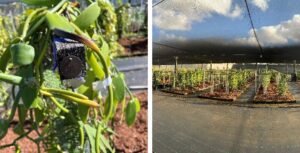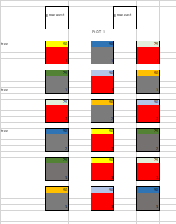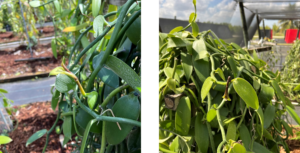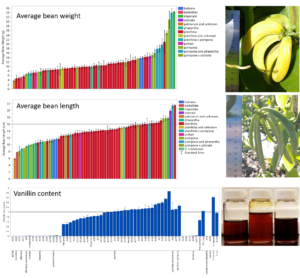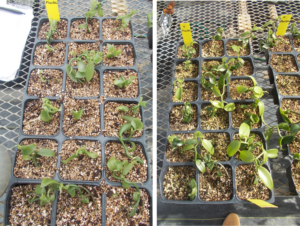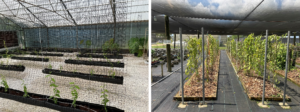Progress report for LS23-381
Project Information
Vanilla is among the highest grossing agricultural commodities by weight, and could revitalize the distressed subtropical agricultural industry. The primary commercial species, V. planifolia, is native to North and Central America, but Madagascar is today’s leading vanilla producer. The United States is the largest importer of cured vanilla beans, but domestic production is currently limited. Domestic vanilla production is becoming increasingly attractive as international supplies are perennially strained and demand for vanilla extract increases as companies like MARS, Unilever, and Nestlé pledge to remove artificial ingredients from their products (ANDRIAMAHERY AND ZHOU, 2018; BROWNELL JR, 2011; TERAZONO, 2017). Growing vanilla beans has the potential to support growers in Florida, Puerto Rico, and the US Virgin Islands striving to meet an evolving consumer base favoring local, organic, and natural products (CHAMBERS, 2018; PEREZ-SILVA et al., 2006). Vanilla also encourages agroforestry and sustainability because it grows in shade and is often cultivated in an agroforestry setting. This natural habitat, combined with the beauty and exoticism of the plant, makes it attractive for agrotourism, providing an additional source of revenue for vanilla farmers and nearby rural communities. Indeed, vanilla has the potential to thrive in Florida, Puerto Rico, and the US Virgin Islands with adapted material producing gourmet-class beans (see Figure 1). Unlike most crops, vanilla has not been domesticated through plant improvement, and today’s industry relies on cultivated, wild clones (SOTO-ARENAS AND CAMERON, 2003). Little information is available about which clones are most suitable and productive for a given region and climate. The biggest challenge inhibiting domestic vanilla production has been the lack of appropriate planting material and scientifically-validated growing information. Therefore, even when vanilla reached a peak of $600/kg in 2019 (~$1.5M per acre gross value), domestic growers were not in a position to benefit from this market. Additionally, the emerging domestic vanilla market requires a supply chain to move product efficiently from farm to end users. Therefore, this project was designed to overcome these challenges and could have major impacts on productivity, profitability, and rural communities. Because of the location of the project, the farmers and communities that would benefit have a high proportion of underrepresented groups. Objectives of this project include 1) Research and development, 2) Extension and grower trials, and 3) Market development and supply chain analysis. We calculate that the USA could be the 5th largest vanilla producer globally with 140 to 670 acres devoted to this specialty crop.
Objective 1. Research and development
1.1 Identify elite vanilla planting material from UF diversity collection including high-yielding types.
1.2 Analyze bean quality through HPLC analysis of vanilla extract.
1.3 Determine optimal shade level to accelerate vanilla plant growth in Florida.
1.4 Communicate results through peer-reviewed publications, public seminars, and grower documents.
Objective 2. Extension and grower trials
2.1 Propagate selected plant material and distribute to grower cooperators
2.2 Distribute growing information to social disadvantaged grower cooperators in English and Spanish
2.3 Collect data from grower plots
2.4 Organize grower field days, symposia, virtual seminars
Objective 3. Analyze market and supply chain development
3.1 Advance farm-to-business activities through pilot projects
3.2 Conduct market analyses
3.3 Hold participatory workshops, facilitate networking events, and establish pilot projects
Cooperators
- - Producer
- - Producer
- - Producer
- - Producer
- - Producer
- - Producer
- - Producer
- - Producer
- - Producer
Research
Material and Methods
Identify elite vanilla planting material through germplasm evaluation. All bean-producing accessions were analyzed for average bean length, bean weight, and vanillin content from the collection maintained at the University of Florida Tropical Research and Education Center (Figure 1). The beans were processed, cured, and analyzed for quality. These beans were harvested and cured using traditional methods for vanillin quantification to determine bean quality. The mature beans were heat processed at 63°C for 3-5 minutes, sweating at 50°C for 48 hours, drying to 25% moisture at 30°C for 2-4 weeks, and extracting vanilla in 35% aqueous ethanol. The HPLC method was used to evaluate the quality metrics such as vanillin content, and major chemical compounds that influence the flavor profile of vanilla.
Figure 1. Vanilla collection at UF/IFAS TREC.
Determine optimal shade level. Vanilla has a long juvenile period before fruit. Optimized growth condition will reduce the juvenile period and have direct impact to the growers. Currently growers use 70% shade for vanilla cultivation which can be optimized for better plant performance. In addition, research has indicated the red and far-red light may be able to promote vanilla growth (Sanchez et al., 2022). A 2 x 3 factorial experiment design was established with three shade levels (50, 70, and 90%) and two light treatments (natural and red) to determine the best shade level and light for vanilla plant growth (Figure 2). Three replicates of six plants are tested for each shade and light treatment. Plant growth data are measured every three months for the duration of the project.
Figure 2. Vanilla light experiment design.
Due to cold front led flower loss in January 2023, less bean was harvested than 2022 (Figure 3). Large variation was observed among the accessions within the collection (Figure 4). Vanilla pompona accessions flowered approximately one month early than V. planifolia accessions. In general, beans from V. planifolia were longer but lighter weight as compared to beans from V. pompona species. V. pompona accessions also showed higher cold tolerance to V. planifolia. V. planifolia beans generally had higher vanillin content than V. pompona accessions. Few hybrids between the two species showed much higher vanillin content than the accessions from the parent species, indicting hybrid vigor. Based on plant adaptation, growth performance and bean quality, three vanilla accessions (two V. planifolia accessions and one V. tahitensis accession) were identified as initial vanilla planting material for distribution.
Figure 3. Vanilla planifolia (left) and V. pompona (right) plant under cold stress.
Figure 4. Phenotypic evaluation of vanilla germplasm collection.
Two Vanilla planifolia accessions were selected and distributed to growers in Florida, and the collaborators in Puerto Rico and U.S Virgin Island for propagation to meet their grower’s needs. In August 2023, 114 vanilla plants were distributed to the University of the Virgin Islands on St Croix. The vanilla plants were planted into trays with 18 3” x 3” cells, and new growth was observed in September 2023 (Figure 5). In Puerto Rico, the V. planifolia cv. Painter plants were distributed to vanilla cooperative growers in this project. The plants were also made available to other members and the public. An initiative to stimulate agrobusiness was established with one acre forest to explore alternative vanilla cultivation in Puerto Rico. The V. tahitensis accession is being propagated to meet all growers’ needs. All three accessions have been preserved in tissue culture to ensure clean plant material to avoid risk of virus infection. A demonstration trial has been established in the fall of 2023 at the University of Florida Tropical Research and Education Center and the grower to meet the training for extension faculties and growers in 2024 (Figure 6).
Figure 5. Vanilla transplanting (left) and adaptation (right) in U.S Virgin Island.
Figure 6. Vanilla production demonstration in central (left) and south Florida (right).
Educational & Outreach Activities
Participation Summary:
Onsite consulting were made to four Florida grower cooperators on vanilla cultivation. Two growers have established their farms in 2023, with two additional growers to complete the infrastructure and farm in 2024. The Cooperative of Producers and Processors of Vanilla in Puerto Rico was officially established and approved in the fall of 2023. The cooperative started with nine partners and has expanded to twenty with more pending applications. The first growing guides has been published in English and distributed to growers and cooperators. One vanilla book (Vainilla Gastronomía y Agroturismo) was developed and published by two members of the vanilla cooperative at PR. One marketing plan workbooks was produced in Florida in both English and Spanish for growers.
In 2023, a four-hour vanilla symposium was organized in Collier County. The event was well received with over 50 participants. The symposium had a positive impact in attracting more growers. Five additional presentations were made to over 100 audiences in south Florida to introduce cultivation information and recruit potential growers. In Puerto Rico, demonstration of cooking using vanilla was shown to local agricultural festivals and traditional tourism areas to have broad impact. Field day was hosted to demonstrate on farm vanilla cultivation with participation from over twelve members from the vanilla cooperative. This event was co-sponsored by the Puerto Rico Department of Agriculture. Vanilla beans, extracts, paste, value-added products, as well as the vanilla cultivation material were exhibited in Organic Market in old San Juan for outreach and distribute information to the public.
Frequent growers’ engagement was conducted in Florida and Puerto Rico. On-farm data collection was not initiated as the vanilla farm are still in the construction process for majority of growers. Virus has been reported to be the major disease issue for vanilla in Florida. No other disease and pest were reported in 2023.
